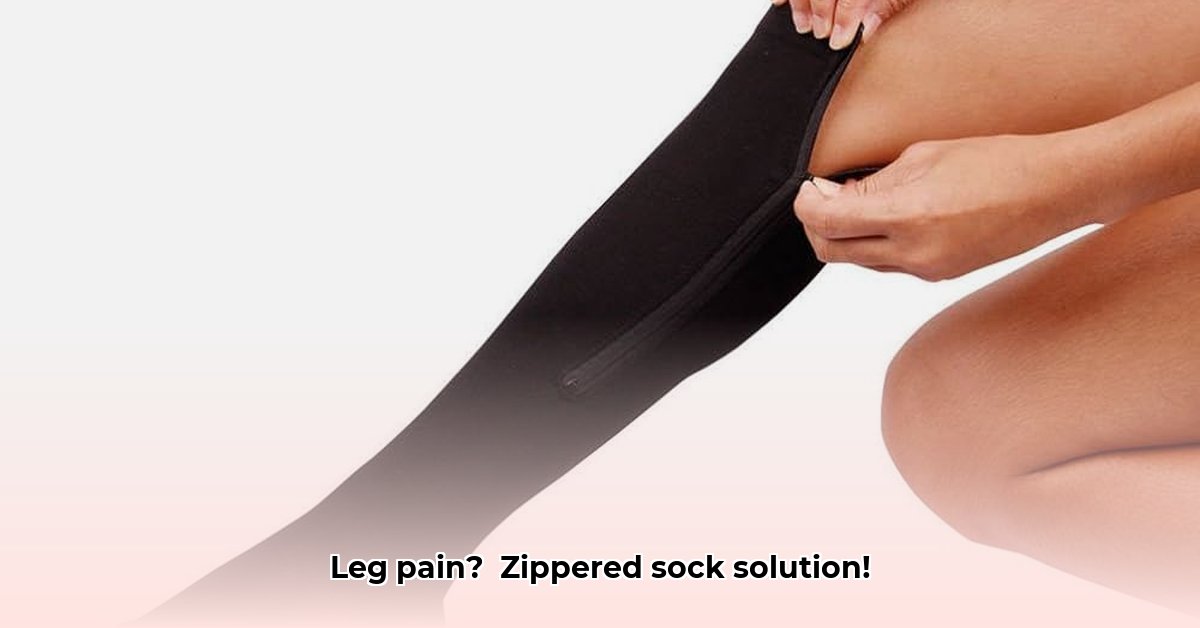Do leg pain, swelling, or circulation problems affect your daily life? The right compression socks can be transformative, and the ease of putting them on shouldn’t be a barrier. This guide explores compression socks with zippers – a user-friendly way to get the support you need. We’ll cover how to choose the right pair, demonstrate proper usage, provide helpful tips, and guide you to reliable purchasing options. Whether you’re a healthcare professional or simply seeking relief, we’ll help you discover the best zippered compression socks for your individual requirements.
The Simplicity of Elastic Socks with Zippers: Enhanced Comfort and Independence
Traditional compression socks can be difficult and uncomfortable to put on, especially for those with mobility issues, arthritis, or limited flexibility. Elastic socks with zippers offer a streamlined and comfortable alternative, making compression therapy more accessible. Have you considered how much easier it could be to manage leg pain and swelling with this simple design?
The Zipper Advantage: Promoting Consistent Wear
Traditional compression socks require significant stretching and physical effort, which can be challenging or impossible for some individuals. The addition of a zipper simplifies this process. The zipper facilitates easy application and removal, allowing you to gradually position the sock around your foot and leg. This design improvement makes it far more likely that you’ll wear your compression socks as often as recommended, maximizing the therapeutic benefits. Consistent wear is key to experiencing the full effects of compression therapy.
Compression Levels Explained: Tailoring Your mmHg to Your Needs
Compression stockings are not a one-size-fits-all solution. They are available in varying levels of compression, measured in mmHg (millimeters of mercury), which indicates the pressure exerted. The higher the mmHg, the greater the compression. The appropriate level depends on your specific condition and medical advice. While mild compression is suitable for minor swelling, more severe conditions like leg ulcers may necessitate firmer compression. Choosing the correct compression level is critical for effective treatment.
Consulting with a healthcare professional is crucial before selecting a compression level. A doctor can properly assess your condition and recommend the right level of compression, preventing potential complications. Incorrect compression levels can be ineffective or even detrimental.
| Compression Level | mmHg Range | Typical Uses | Who Might Need This? |
|---|---|---|---|
| Mild | 8-15 | Minor swelling, early varicose veins, tired legs | Individuals with slight leg discomfort or those who stand for long periods. |
| Moderate | 15-20 | Moderate swelling, varicose veins, post-surgical recovery, travel | Individuals recovering from surgery, pregnant women, or those with moderate venous insufficiency. |
| Firm | 20-30 | Significant swelling, leg ulcers, DVT prevention, lymphedema | Patients with chronic venous insufficiency, deep vein thrombosis risk, or leg ulcers. |
| Extra Firm | 30-40 | Severe lymphedema, post-thrombotic syndrome (prescription required) | Individuals with severe venous or lymphatic conditions, under medical supervision. |
Disclaimer: This information is for educational purposes only and does not substitute professional medical advice. Always seek the guidance of your physician or a qualified healthcare provider for any questions you may have regarding your health or medical condition.
More Than Just Convenience: Key Health Benefits
Zippered compression socks offer several notable health and wellness benefits:
- Enhanced Circulation: Compression improves blood flow, reducing swelling and discomfort associated with poor circulation in the legs. Reduced swelling translates to less pain and increased comfort throughout the day.
- Pain Reduction and Increased Flexibility: Many users report reduced pain from leg swelling and conditions like varicose veins with regular use of compression socks. Decreased swelling also enhances mobility, facilitating easier movement and daily activities.
- Potential Reduction in Risk of Blood Clots: Studies are ongoing, but some research suggests that compression therapy may help lower the risk of blood clots, particularly for individuals who spend extended periods sitting or standing. Consult your healthcare provider to determine if compression therapy aligns with your overall health plan.
Considerations Before Purchase: Your Zippered Compression Socks Guide
Before buying, consider these factors to ensure you select the right socks:
- Optimal Sizing: Accurate sizing is essential. Compression socks that are too tight can impede blood flow, while loose socks won’t provide adequate compression. Measure your legs carefully and refer to the manufacturer’s sizing chart. Measure around the ankle, calf and thigh to ensure proper gradient compression.
- Material Choice: Choose breathable materials such as cotton, nylon, or moisture-wicking synthetic blends. These prevent skin irritation and maintain comfort, especially for sensitive skin. Decide if you prefer thicker socks for warmth or lighter ones for warmer climates.
- Durability Assessment: Given regular use, durability is important. Opt for socks made from durable materials that withstand frequent washing without losing elasticity. Check customer reviews for insights on product longevity.
Finding the Perfect Fit: A Personalized Approach
Finding the ideal zippered compression socks may require some experimentation. Personal preferences vary, so a product that suits one person may not be suitable for another. Try different brands and materials to find the optimal fit for your needs. Medical professionals or specialized stores can provide tailored recommendations. The goal is to find socks that you can wear comfortably and consistently to maximize the health benefits. Read reviews, ask questions, and seek professional advice to find your perfect pair. The added comfort and support is worth the effort!
Choosing the Best Compression Stockings with Zippers for Diabetes Management: Prioritizing Foot Health
Key Considerations:
- Compression stockings improve circulation and reduce swelling for diabetic patients.
- Zipper designs offer ease of use, beneficial for those with limited mobility.
- Consult a healthcare provider to determine the correct compression level (mmHg).
- Select breathable, moisture-wicking materials to prevent skin issues.
- Regular replacement and diligent foot care are essential.
How Compression Stockings with Zippers Benefit Diabetic Patients
Managing diabetes often involves addressing leg issues like swelling and poor circulation. Compression stockings can improve blood flow, offering significant relief. The addition of zippers makes these stockings easier to put on and take off, which is particularly helpful for those with limited dexterity. Zippers contribute to easier and more effective diabetic foot care.
Selecting the Right Compression Level: Medical Advice is Crucial
Determining the appropriate compression level, measured in mmHg, is crucial for diabetic patients. Always consult your doctor or podiatrist for personalized recommendations. An incorrect level of compression can either restrict blood flow or fail to provide sufficient benefit. Your healthcare provider’s guidance is vital.
Material Matters: Fabrics for Diabetic Foot Health
The choice of material for compression stockings is as important as the compression level. Opt for breathable and moisture-wicking fabrics to prevent sweat buildup and reduce the risk of skin irritation or infection, which are significant concerns for diabetics. Consider seamless socks made from materials like cotton blends, bamboo, or merino wool to minimize friction and maximize comfort.
Achieving the Perfect Fit: Maximizing Comfort and Efficacy
Proper fit is essential for compression stockings to be effective and comfortable. Stockings that are too tight can impede circulation, while loose socks won’t provide adequate support. Consult the manufacturer’s size chart and measure your legs accurately before ordering.
The Convenience of Zippers: Enhanced Independence
Zippers significantly improve the usability of compression stockings. They provide an accessible option for individuals who may struggle with traditional stockings, making self-care more manageable and promoting independence.
Maintenance Guidelines: Ensuring Long-Term Effectiveness
Compression stockings require regular maintenance. Frequent use can reduce their elasticity and effectiveness, so inspect them regularly for signs of wear. Most manufacturers recommend replacing them every 3-6 months, or sooner if damage is apparent.
- Your Perfect Bento Box Bag For Fresh And Tidy Meals - December 2, 2025
- Korean Meal Prep Made Easy For Delicious Weekday Meals - December 1, 2025
- Korean Food Meal Prep Makes Flavorful Weekday Meals Simple - November 30, 2025










